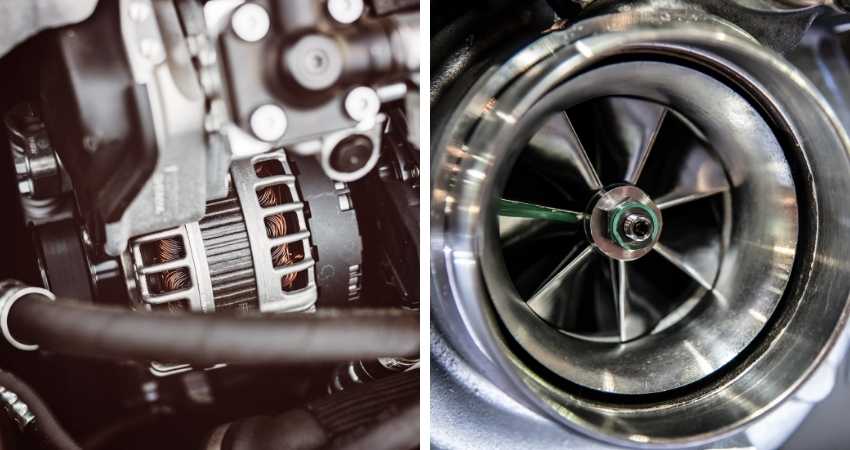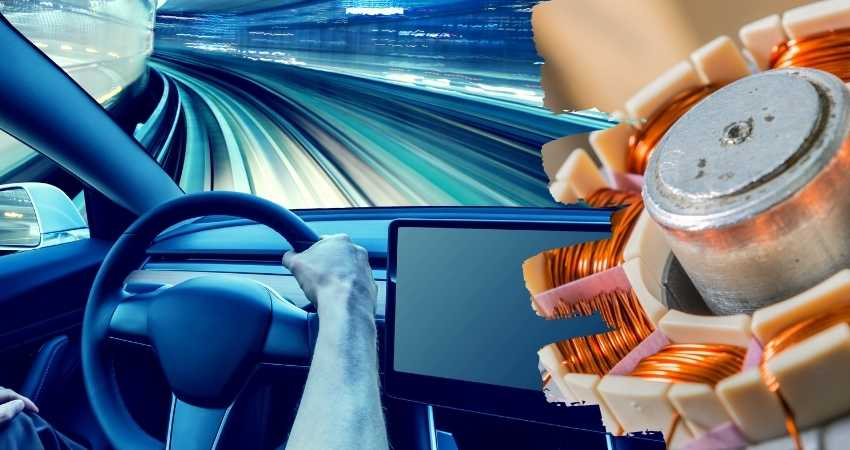All electric cars get moving due to motors that are far more efficient than gasoline engines. Therefore, motors are like the heart of electric cars, and every other component might be of secondary importance. However, did you know most electric cars run on AC-type motors, while some are on the DC type? Why does this difference exist?
Electric cars use AC motors because of their many benefits, such as their ability to charge the battery, tread rough terrain easily, offer high accelerations, and last longer.

Why Do Electric Cars Use AC Motors?
1. They Charge the Battery
AC motors can act as generators when the driver lets the accelerator pedal loose. The stator starts working like a rotor, and the current direction reverses that, in turn, charges the battery, adding some precious miles to an electric car’s range.

Let us explain. Electric cars with AC motors have braking pads that slow down the vehicle when the driver does not accelerate and lets the car coast. But since the stator does not have current at that moment, the slowing down of the rotor pushes the current into the stator, which then goes into the battery and charges it.
2. AC Motors Produce Greater Torque
Though DC motors are good at making efficient use of current, their AC counterparts use high current to generate enormous torque – the rotational energy used to rotate the wheels of an electric car.

This particular benefit of AC motors has given some formidable features to electric cars:
- Easy on Rough Terrain: Moving on a rugged surface is not a piece of cake. Therefore, AC motors provide sufficient power to drive on rough terrains..
- Better Acceleration: AC motors are excellent at speeding up when each push is made on the accelerator pedal. Add the varying frequency dimension; these motors can provide great pace and inertia.
| Fact!
Toyota Prius gets a bad reputation for being slow to pick up the speed. The reason lies in the brushless DC motor it uses. |
3. They Are Durable
DC motors have a comparatively lesser lifespan due to complex structures. AC motors last long due to their simplicity: they do not have commuters, brushes, and other sophisticated parts that might wear and tear quickly if not maintained.

Electric car motor replacement can cause thousands of dollars, and the AC motor technology comes as a sigh of relief in this regard. They do not need repair or too much maintenance after every few years. Some sources also claim that these motors can outlast the life of an electric car itself.
4. They Are Smaller and Lighter
AC motors are more compact and lighter when compared to DC ones, giving off multiple benefits: Lesser space is consumed in a vehicle and the acceleration enhances while the time required to full stop also decreases.
AC motors have this edge over their DC equivalents mainly because they only have one winding, no permanent magnet, and no internal cooling system.
5. They Do Not Heat Much
Overheating in electric cars can be dangerous because of the lithium-ion battery fire risk. Since DC motors are known for overheating and may also have a separate cooling system to avoid it, AC motors are a good choice as they do not generate much heat.

Unfortunately, electric car batteries do not bear too much heat and considering some models with motors and batteries placed closely together, DC motors could be a big no. AC motors thus become a popular choice in terms of safety.
6. They Are Quieter and More Static
AC motors play a big role in making electric cars quieter than traditional ones. Thanks to decreased vibrations and noises mainly due to brushless structure, AC motors are almost silent.

As the DC motor shaft rotates, the commutator brushes can bounce, creating noise and vibrations throughout the power line. The noise and vibrations can go even further if more torque or acceleration is produced.
7. They Are Programmable
Though programmable DC motors also exist, they generally do not for electric cars. Drivers can easily adjust their desired parameters using AC motors to drive the car as they wish.
Users can adjust the maximum battery voltage range, for instance, in the electric cars they want to operate. As the battery will not dispense more than the desired power, the range will be impacted significantly.
8. They Reverse Easily
Reversing in DC motors is not so simple. On the other hand, AC motors can rotate the shaft in the opposite direction with only a simple mechanism. In AC motors, only the sequence of phases is swapped, and the shaft starts rotating in the opposite direction.

9. DC Motors Are Just Not an Easy Choice Right Now
Due to some economic issues, rare earth minerals are mostly controlled by a single country and the prices have not been stable as well.
In such circumstances, if electric car manufacturers opt for DC motors, it would most likely, lead to enhanced prices since they have to make millions of units per year. Right now, China controls about 90 percent of rare earth minerals. The diplomatic and economic rows between the US – the home to Tesla, the largest EV producer – and China have become commonplace.
Read: Why Does the Electric Car Motor Produce More Torque at Slow Speeds?
What Are the Benefits of Using DC Motors in Electric Cars?
1. They Be Comparatively Cheaper
AC motors are more expensive than DC motors in terms of one-time cost. However, when maintenance is concerned, DC motors turn out to be costlier due to their sophisticated design and requirement for regular rectification of issues. Also, the DC motors that provide regenerative features are more expensive.
The price difference between the two types of motors exist, perhaps, because of the easier design of DC motors, especially the brushless ones.
2. They Are More Energy Efficient
Traditionally, AC motors suffer from induction current losses and are considered 30 percent less efficient than their DC counterparts. The latter also has a permanent magnet that enhances its efficiency. However, many other factors, such as the lighter weight and size of AC motors, make them more suitable if the car is considered a system as a whole.
3. They Do Not Need an Inversion Mechanism
DC battery gives DC to DC motor. This simple system does not require a DC battery to use invertors and run an AC motor. Using such mechanisms can somehow impact the overall cost of an electric car due to its simple structure.
Why Do Electric Cars Use AC Motors? An Overview
| Benefits of AC Motors | Benefits of DC Motors |
|
Regenerative charging Greater torque Better grip on uneven terrain High acceleration Last Longer Compact design and lesser weight Low noise and vibrations Programmable No production issues |
Some types might be cheaper Uses energy efficiently No inversion mechanism is required |
Famous Car Brands Using AC and DC Motors
- Chevrolet
- Nissan
- Tesla
AC vs DC Motor: Which One Is Better for Your Electric Car?
Your choice of an AC or a DC motor depends on the use. If you live in a city with no hilly terrain and the roads are plain with an adequate amount of EV charging stations, you should go for DC motor electric cars..
Why Do Electric Cars Use AC Motors? Final Words
DC motors are expected to continue dominating the hybrid vehicle world, while AC ones will remain the chief part of electric cars. However, the possibility that the currents might change still exists: several well-known car brands have rolled out DC motor-powered electric vehicles. These include Tesla Model 3 and Nissan Leaf. DC motors might be the future of electric cars, who knows?


